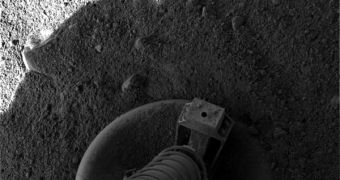Back in 2008, the NASA Phoenix Mars Lander made its way to the surface of the Red Planet, landing close to the north pole. Immediately upon descent, experts found beads of saltwater on the spacecraft's legs. Now, they are investigating whether this mixture can support life.
Researchers at the University of Michigan (U-M) are leading the global science group that is analyzing this complex issue. Here on Earth, lifeforms do not readily live in waters featuring high concentrations of salt, but exceptions are known to occur.
The thing on Mars is that the large volumes of salt permeating the frozen water trapped near the north pole are what allows the chemical to remain liquid. At average temperatures of between minus 100 and minus 80 degrees Fahrenheit, water cannot remain liquid in a natural manner.
However, adding salt to the mix is known to drop the liquid's freezing point considerably. Given this particularity the planet exhibits, is it a stretch to assume that lifeforms there may have evolved to adapt to these high salt concentrations?
Experts have been pondering this issue for quite some time, but the problem is very complex. Things are even more difficult to establish in light of the fact that we only know how life looks like here on Earth, but have no other instances to compare it with.
“On Earth, everywhere there's liquid water, there is microbial life. If we find microbes that can survive and replicate in brines at Mars conditions, we would have demonstrated that microbes could exist on Mars today,” U-M expert Nilton Renno says.
The research scientist holds an appointment as a professor in the U-M Department of Atmospheric, Oceanic and Space Sciences, and was also the principal investigator of the research, Daily Galaxy reports.
The team also includes experts from NASA, the University of Texas in Dallas, the University of Georgia and the Centro de Astrobiologia, in Madrid, Spain. They say that microorganisms which are called extremophiles here on Earth may endure in the roughest conditions.
Unlike larger, more complex organisms, they do not require anything other than a thin film of water to carry our their metabolic processes. At the same time, they can put themselves in a state of hibernations for periods of time ranging from tens of thousands to millions of years.
If meteoric samples found here on Earth are any indication, then some of these microbes might have made their way to Mars via a process of planetary cross-contamination. This occurs when space impacts remove pieces of a planet, which then roam in space until finally reaching another planet.
Earth and Mars have been proven to have had such contact, while extremophiles were proven capable of withstanding asteroid impacts, ejection to space, living in weightlessness, surviving atmospheric reentry and colonizing new environments.

 14 DAY TRIAL //
14 DAY TRIAL //